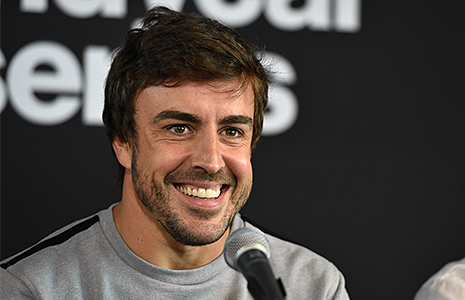Fernando Alonso has 2.46 million followers on Twitter. Combined, the 21 starters in Sunday’s Verizon IndyCar Series race in Alabama have 2.01 million followers.
Ponder that for a moment. One racer is more popular on social media than an entire field of racers. One racer has nearly four times as many followers as the most popular tweeter in the Verizon IndyCar Series (for the record, it’s Tony Kanaan with 669,000 followers).
Certainly, Twitter is far from a scientific poll, but it’s a reasonably accurate measure of one’s popularity. And, as 2.46 million screams out loud, Alonso is remarkably popular.
 So this is for the cynics and critics of Alonso’s participation in the 101st Indianapolis 500 presented by PennGrade Motor Oil. This is a big deal. This does make a difference. Not only will it move the needle, it has the potential to peg it.
So this is for the cynics and critics of Alonso’s participation in the 101st Indianapolis 500 presented by PennGrade Motor Oil. This is a big deal. This does make a difference. Not only will it move the needle, it has the potential to peg it.
Critics have called it a publicity stunt, a blatant attempt to get eyeballs on the screen and butts in the seats. While that will be an added benefit, it’s an effect, not a cause. The cause is Alonso’s desire to win motorsports’ career Triple Crown. The effect is that people want to witness it.
For the uninitiated, the Triple Crown is winning the Indianapolis 500, the 24 Hours of Le Mans and the Monaco Grand Prix – or, as a suitable facsimile, the Formula One championship. Only one driver – British legend Graham Hill – has won all three. Only 17 drivers have attempted the Indy/Le Mans/Monaco version of the feat. Since 1987, Indy and Monaco have been held on the same day, making the Triple Crown difficult – if not impossible – to accomplish.
That’s why Alonso took the chance. His F1 season isn’t going anywhere, so skipping a race isn’t terribly damaging. He’s won Monaco twice, he’s 35 years old, and he's considering his legacy. Indy and Le Mans are on his radar. They’re winnable. Even if he doesn’t win them, the joy is in the attempt.
“I started thinking, ‘Who attempted to win all those three?’” Alonso said Sunday before the Honda Grand Prix of Alabama at Barber Motorsports Park. “The driving techniques and preparation are unique to each series. It’s going to be very challenging and difficult. In fact, only one man in history did it, and it was different times. Now, I think it’s even more difficult.
“I started thinking, ‘Wow, maybe this is my target.’ In Formula One, I’m learning – every day you learn – but there is a point where more or less you are stuck in your driving style, etc. To be a better driver, a greater driver, I need to learn something outside Formula One, and this is the first experience.”
Alonso’s Wikipedia entry says he’s “often regarded as one of the greatest Formula One drivers.” That’s like saying LeBron James is a fairly decent basketball player. Alonso’s 32 victories rank sixth all-time. That’s more than F1 greats like Nigel Mansell, Jackie Stewart, Jim Clark and Juan Manuel Fangio. The argument that Alonso is the best active racer in the world is legit.
Yet that point is often lost in the United States. Americans can be maddeningly obtuse about the outside world, and sports reflect that attitude. Things that occur beyond the shores are often overlooked by Americans. Internationally, F1 is a monster. Nationally, it’s but a blip. A small but loyal group of American fans hang on every live F1 broadcast and read every piece of news, but mainstream sports media avoid it altogether. The Alonso/Indy story received a who?/what? in the States.
But beyond the borders, the story is massive. Indianapolis Motor Speedway officials are fielding so many requests from international media to cover the race, they’re not sure where to put them all. Likewise, ticket sales are up and TV ratings outside the U.S. are expected to spike when the green flag waves May 28.
Alonso’s participation in the Indy 500 reiterates the global status of the race. It renews and expands international attention. It is a big deal, even if Americans don’t fully get it.
It might not shake the earth in the U.S., but it will shake the earth.